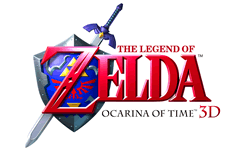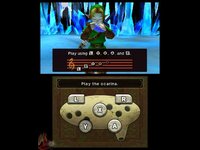|
|

|
PLATFORM
|
3DS
|
BATTLE SYSTEM
|

|
INTERACTION
|

|
ORIGINALITY
|

|
STORY
|

|
MUSIC & SOUND
|

|
VISUALS
|

|
CHALLENGE
|
Moderate
|
COMPLETION TIME
|
20-40 Hours
|
|
OVERALL

|
+ Interface improvements are a welcome upgrade.
+ Significantly improved visuals.
+ Navi doesn't ask you to listen as much.
- Glasses-free 3D and motion-controlled camera don't mix.
- Visuals are better without the 3D effect.
|
Click here for scoring definitions
|
|
|
Few games are as widely revered as The Legend of Zelda: Ocarina of Time. Indeed, Nintendo's 1998 smash hit is widely regarded as one of the greatest video games ever made. And why not? With ground-breaking gameplay, unrivaled visuals, and a story that's timeless and memorable, Ocarina of Time set itself apart in a way that few video games have ever managed to do. Of course, that was thirteen years ago. Things have changed a lot since the days of Nintendo's little black box. Today, we enjoy modern breakthroughs like high definition graphics, motion controls, and even little things like a second analog stick. It's easy to wax nostalgic about a game that holds such a dear place in the hearts of so many, but rose-colored glasses aren't necessary to realize that The Legend of Zelda: Ocarina of Time 3D is a fantastic port of a fantastic game.
Although the Legend of Zelda series encompasses many different incarnations of its eponymous hero Link, Ocarina of Time represents the beginning of the timeline, taking place well before the original NES classic. In this iteration, Link is a young Kokiri boy living in the forest under the protection of the Great Deku Tree. As the only forest child who doesn't have a fairy companion, he lives as an outsider, until one day the Great Deku Tree sends the fairy Navi to his side, summoning them both to undertake an important quest. Outside the forest, the evil Ganondorf, king of the Gerudo thieves, is plotting to steal the sacred Tri-Force, an object of immeasurable power. With the help of Princess Zelda, Link must find a way to stop the villain's plot and save the land of Hyrule from a terrible fate. This adventure takes him not only all over Hyrule, but through time itself, lending him the moniker "The Hero of Time."
Though simple and riddled with what more cynical players might consider clichés, there is an undeniable elegance to Ocarina of Time's story. Indeed, it bears all the markers of a classic myth or legend that would feel right at home in various folklores. It lacks the emotional depth of Twilight Princess and the creative setting of Wind Waker, but it embodies the spirit of the franchise better than any other title in the series and sets the stage for the adventures of Link's descendants. As Link returns the Master Sword to the pedestal at the game's conclusion, it's easy to conjure up memories of future adventures where other Links return to the same place, retrieving the same sword, hundreds of years apart.
 The new bottom-screen interface is a much-welcomed improvement.
The new bottom-screen interface is a much-welcomed improvement.
|
|
Ocarina of Time's once ground-breaking gameplay has likely since become second nature to most RPGamers. Like every Zelda game, it splits its focus between exploration, puzzle-solving, and combat. The expansive Hyrule Field lies at the center of the game, connecting to various areas which contain puzzles, secrets, and of course fiendish dungeons which will test the wit and will of all players. As Link explores, he'll discover new items and weapons that can be used to solve puzzles and defeat enemies, including some truly epic boss encounters. For those who haven't played any of the modern Zelda titles, Link can lock onto a target with the L-button, raise his shield with the R-button, and use the various face buttons to attack, roll, or activate items. Certain items can also be aimed manually in first-person mode, and these two methods of interaction are used to defeat most enemies in the game.
Level design is probably Ocarina of Time's strongest area. Hyrule is not only expansive, but brilliantly constructed to provide puzzles and obstacles at nearly every turn, whether in the depths of a dungeon or galloping across Hyrule Field. While all of the levels have their highlights, certain ones stand out as particularly impressive. The Water Temple's complicated, three-floor layout is as fiendish as it is clever, the Spirit Temple makes use of both Link's adult and child forms, and the Forest Temple's space-warping areas can confuse even the most intrepid traveler.
While the original game has remained essentially unchanged, the 3DS port adds some extremely welcome interface improvements. Most notably, the game eschews the traditional menu of the N64 classic for a touch-controlled one, and it proves to be a significant upgrade. The dungeon or world map is laid out in the center, with small, thumb-sized buttons laid out around the edges. Of particular note is how equipping various items is handled. While the original version featured three slots bound to the C-buttons on the N64 controller, the 3DS version now has four slots: two are activated by pressing the X or Y buttons, while another two are strictly touch-screen enabled. Link's ocarina, an important gameplay element and the title's namesake, has its own button on the bottom left-hand corner, freeing up another item slot.
Interestingly, Ocarina of Time 3D also acts as something of a showcase for the 3DS, highlighting the system's strengths and weaknesses. One thing that stands out in particular is that the 3D the system is hailed for may not actually be all that it's cracked up to be. While the 3D effects are impressive to say the least, turning the 3D off results in a noticeable improvement in visual quality. Aliasing issues are smoothed out, colors are more vivid, and battery life is improved. Further, it turns out that combining glasses-free 3D and gyroscopic motion controls might not have been the brightest idea. In this case, the motion controls can be used to control the camera at times, a feature that's quite useful in many situations. Unfortunately, making use of this feature requires you to move the 3DS, which inevitably breaks the 3D effect. In practice, you can have one or the other, but not both. They just don't mesh well.
 Thankfully, no microphone controls were added for the Ocarina.
Thankfully, no microphone controls were added for the Ocarina.
|
|
Speaking of visuals, this is one department where Ocarina of Time crosses the line from port to full-fledged remake. The improvements are immediately noticeable, from improved polygon counts to larger, more-detailed textures. Special effects like water and the sky have been overhauled, looking smoother and more beautiful than ever before.
Of everything that Ocarina of Time added to the world of video games, perhaps the most beloved is its soundtrack. As suggested by the game's title, music plays a major role in both the story and the gameplay, and the soundtrack that accompanies the game is by far one of gaming's best. Many of these pieces have ingrained themselves in gaming culture. "Zelda's Lullaby" is probably the most recognized and most important piece at play here, its melancholy, three-note melody showing up just about everywhere. Apart from the music, players will be happy to know that Navi's infamous "Hey! Listen!" babble has been cut down significantly, reducing mental stress by as much as fifty percent.
If you played Ocarina of Time back in 1998, you probably don't need to know much about this game. It's a piece of gaming history, a classic in a medium that's still very early in its existence. What's remarkable about the game is that it's aged far better than most of its contemporaries. It's still fun, it's still relevant, and it's still Zelda. That's really all that needs to be said.
Review Archives
|









